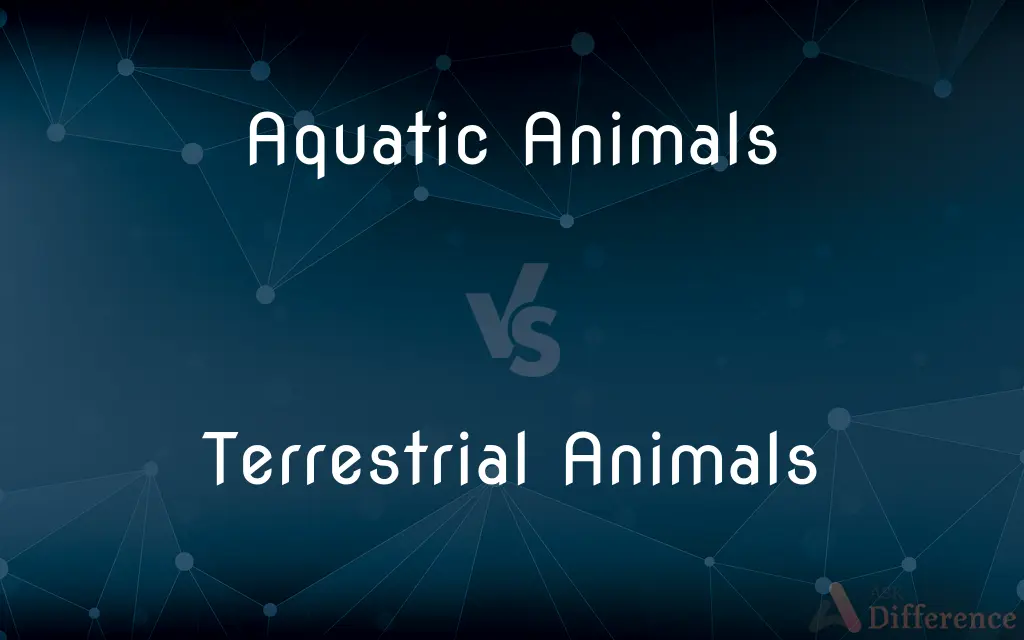Aquatic Animals vs. Terrestrial Animals — What's the Difference?
Edited by Tayyaba Rehman — By Fiza Rafique — Published on December 15, 2023
Aquatic Animals live in water; Terrestrial Animals inhabit land.

Difference Between Aquatic Animals and Terrestrial Animals
Table of Contents
ADVERTISEMENT
Key Differences
Aquatic Animals are species that have adapted to life in water, whether it be freshwater or saltwater environments. Terrestrial Animals, conversely, are creatures that have evolved primarily for life on land. These distinctions play a significant role in the anatomical, behavioral, and physiological differences between the two groups.
Gills, fins, streamlined bodies, and specialized reproductive systems are common characteristics of Aquatic Animals, which enable them to thrive in their watery habitats. Terrestrial Animals, on the other hand, often have legs for movement on land, lungs for breathing air, and varying skin types, such as fur or scales, that suit their particular environmental needs.
Aquatic Animals face challenges like buoyancy, salinity, and water pressure, which have influenced their evolutionary paths. Many have developed air bladders to maintain buoyancy or salt-excreting glands to handle varying salinity levels. In contrast, Terrestrial Animals grapple with factors like gravity in a more pronounced manner, and thus have robust skeletal structures. They also deal with variations in temperature and must find ways to regulate their internal heat.
Ecosystem dynamics also vary. Aquatic Animals are part of intricate food webs, with relationships spanning from the tiniest plankton to massive whales. Terrestrial Animals too are part of complex ecosystems, but their interactions span across forests, deserts, grasslands, and other land-based habitats. Predation, competition, and symbiosis are just a few interactions seen in both realms.
Lastly, while both Aquatic and Terrestrial Animals play essential roles in their respective ecosystems, human activities affect them differently. Aquatic Animals face threats from overfishing, pollution, and habitat destruction, while Terrestrial Animals often contend with deforestation, urbanization, and climate change.
ADVERTISEMENT
Comparison Chart
Habitat
Water-based environments
Land-based habitats
Respiratory System
Typically gills
Typically lungs
Movement Adaptations
Fins, streamlined bodies
Legs, wings, varied skeletal structures
Reproductive Systems
Many lay eggs in water
Diverse methods, many lay eggs or give live birth
Major Threats
Overfishing, pollution, habitat destruction
Deforestation, urbanization, climate change
Compare with Definitions
Aquatic Animals
Aquatic Animals face unique environmental challenges.
Coral reefs house a plethora of Aquatic Animals, many threatened by ocean acidification.
Terrestrial Animals
Terrestrial Animals inhabit various biomes from forests to deserts.
While camels are Terrestrial Animals of deserts, tigers prowl in forests.
Aquatic Animals
Aquatic Animals reside primarily in water.
Dolphins are popular Aquatic Animals known for their intelligence.
Terrestrial Animals
Terrestrial Animals showcase a diversity of adaptations for land-based life.
Birds, a group of Terrestrial Animals, have wings for flight.
Aquatic Animals
Aquatic Animals can be found in both freshwater and marine ecosystems.
While goldfish are freshwater Aquatic Animals, sharks dominate the oceans.
Terrestrial Animals
Terrestrial Animals engage in multifaceted land-based food webs.
From insects to apex predators, Terrestrial Animals define intricate ecological relationships.
Aquatic Animals
Aquatic Animals form intricate underwater food webs.
From tiny krill to colossal whales, Aquatic Animals play vital roles in marine food chains.
Terrestrial Animals
Terrestrial Animals predominantly live on land.
Elephants, the large Terrestrial Animals, roam the African savannahs.
Aquatic Animals
Aquatic Animals possess features adapted to watery environments.
Fish, common Aquatic Animals, breathe using gills.
Terrestrial Animals
Terrestrial Animals must regulate internal temperatures in varied climates.
Many Terrestrial Animals, like reptiles, bask in the sun to warm up.
Common Curiosities
Do Terrestrial Animals have gills?
No, most Terrestrial Animals breathe air using lungs.
Which animals might be considered both aquatic and terrestrial?
Amphibians, like frogs, can live both in water and on land.
How do Terrestrial Animals handle temperature changes?
Terrestrial Animals employ various mechanisms, like fur or behavioral adaptations, to regulate temperature.
Where do Aquatic Animals primarily live?
Aquatic Animals primarily inhabit water environments.
How do most Aquatic Animals breathe?
Many Aquatic Animals, like fish, use gills to extract oxygen from water.
What's the main habitat of Terrestrial Animals?
Terrestrial Animals mainly live on land.
Are whales considered fish or mammals?
Whales are mammals and are Aquatic Animals.
Do any Aquatic Animals come onto land?
Some Aquatic Animals, like sea turtles, come onto land, especially to lay eggs.
Why do fish have fins?
Fins aid Aquatic Animals in swimming and navigating water.
Do all Aquatic Animals live in oceans?
No, Aquatic Animals can be found in freshwater habitats too, like rivers and lakes.
Why do some Terrestrial Animals have thick fur?
Fur helps many Terrestrial Animals insulate against cold temperatures.
How are Terrestrial Animals affected by human activities?
Terrestrial Animals face challenges like habitat loss, hunting, and climate change.
Which is more diverse, aquatic or terrestrial ecosystems?
Both aquatic and terrestrial ecosystems have immense biodiversity, but this can vary based on specific regions and conditions.
What challenges do Aquatic Animals face?
Aquatic Animals face threats like pollution, habitat destruction, and overfishing.
What types of Terrestrial Animals are found in rainforests?
Rainforests house diverse Terrestrial Animals, from monkeys to jaguars.
Share Your Discovery

Previous Comparison
Rice Vinegar vs. White Vinegar
Next Comparison
Discrete Variable vs. Continuous VariableAuthor Spotlight
Written by
Fiza RafiqueFiza Rafique is a skilled content writer at AskDifference.com, where she meticulously refines and enhances written pieces. Drawing from her vast editorial expertise, Fiza ensures clarity, accuracy, and precision in every article. Passionate about language, she continually seeks to elevate the quality of content for readers worldwide.
Edited by
Tayyaba RehmanTayyaba Rehman is a distinguished writer, currently serving as a primary contributor to askdifference.com. As a researcher in semantics and etymology, Tayyaba's passion for the complexity of languages and their distinctions has found a perfect home on the platform. Tayyaba delves into the intricacies of language, distinguishing between commonly confused words and phrases, thereby providing clarity for readers worldwide.












































